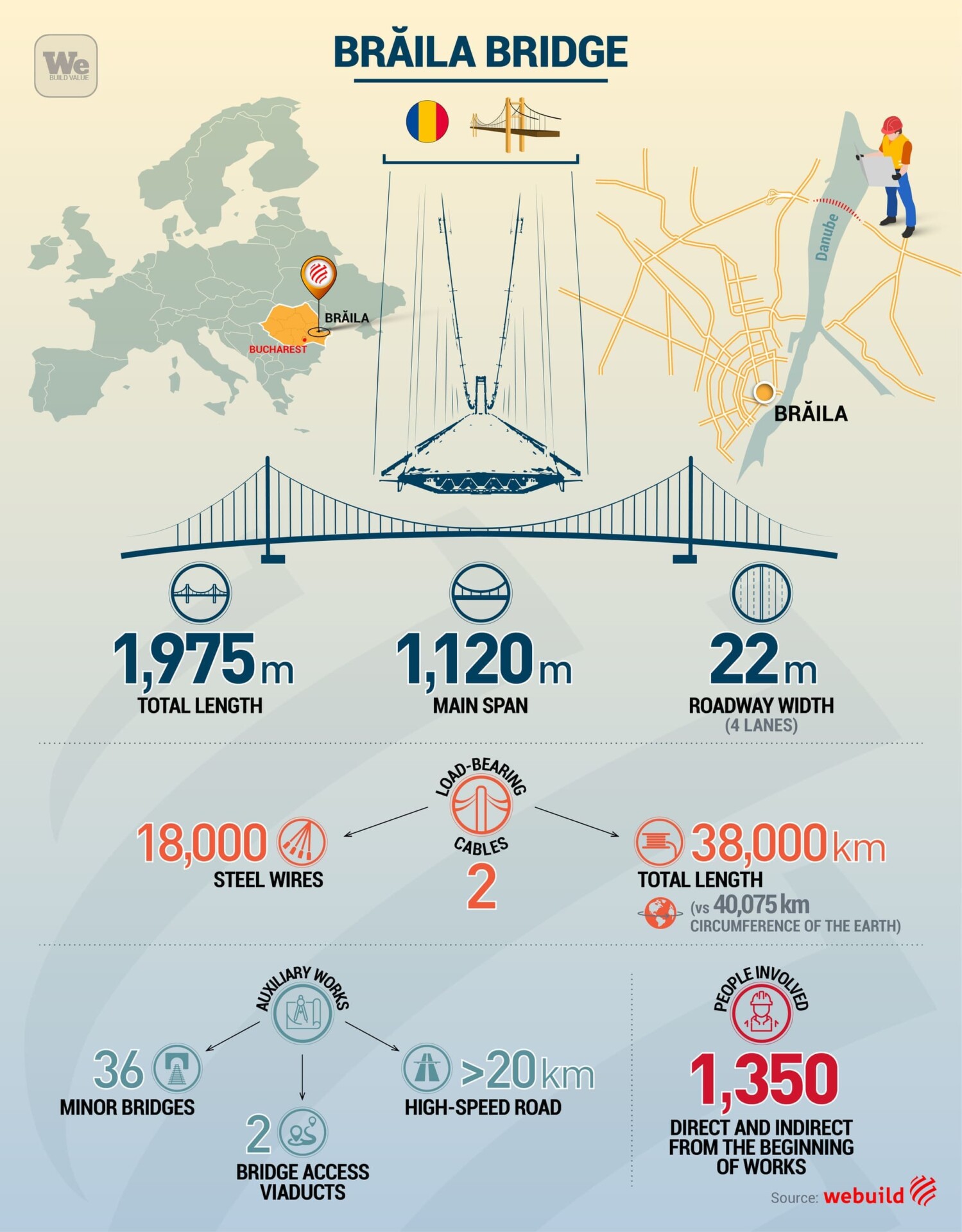Only a few days are left, and Europe will be able to christen another infrastructural record. In Romania, on the waters of the Danube, the Brăila Bridge is about to be inaugurated, becoming the second longest suspension bridge in the continent in terms of the length of its central span. We’re talking about 1,120 meters that float on the waters of the mighty river, with a width of 31.7 meters and two towers standing at 192.4 meters, two true skyscrapers overlooking the shores and opening a new transit route that is destined to profoundly change the mobility of the entire region.
Brăila, a town with 200,000 inhabitants in eastern Romania, has always viewed the Danube as an insurmountable barrier but at the same time as a great opportunity for wealth. The economy of the town is mainly based on the commercial exchanges ensured by the river, which is just 8 kilometers away from Brăila and 95 kilometers from its delta.
From this, we can understand the strategic importance of the new bridge, which, on one hand, allows medium-sized oceanic vessels to pass under its span, and on the other hand, offers travelers the possibility to reach the opposite shore in just two minutes, compared to the 45 minutes it took before its construction.
Brăila Bridge: building a great public work
A large suspension bridge is one and many works together. Its total length of 1,975 meters and a span of 1,120 meters are just the most visible elements among the hundreds of structural interventions required by such an infrastructure.
The Brăila project, in addition to the bridge built by the Webuild Group, also includes the construction of 36 smaller bridges, two access viaducts, and 21 kilometers of express roads. To give an idea of the magnitude of the project, the two main supporting cables that hold the span are made up of 18,000 steel wires, with a total length of 38,000 kilometers, which is slightly less than the Earth’s circumference.
This is not only a grandiose project but also an innovative and sustainable one. Due to the soil conditions and considering the medium seismicity of the area, special construction techniques have been adopted, such as the use of large-diameter piles for foundations, extensive and deep excavation of wells, as well as innovative systems for extracting water from underground aquifers.
Maximum attention has been devoted to every element of the project, starting with the concrete used, to the point that the bridge was awarded the AICAP Prize, which promotes Italian excellence in the use of structural concrete. The Certificate of Excellence was awarded in 2022 by the Italian Association of Reinforced and Prestressed Concrete, which recognized the complexity involved in constructing the towering towers and the size of the anchoring blocks that firmly hold the bridge to the ground. In fact, the anchoring blocks alone have a diameter of 47 meters and a depth of 31 meters, similar in size to those of great bridges like the Akashi Bridge in Japan, the second-largest suspension bridge in the world.
A bridge that changes European transport
There are infrastructure projects that are more strategic than others, works that, due to their characteristics and nature, contribute to profoundly changing the social and economic landscape of a region. The Brăila Bridge is one of these, thanks to its broad impact. On one hand, it will accommodate the passage of around 7,000 cars per day, and on the other hand, it will facilitate the transit of oceanic vessels carrying goods on the Danube.
It is precisely due to its uniqueness and economic impact that this project is the result of a joint initiative commissioned by CNAIR for the Romanian Ministry of Transport and Infrastructure and funded by the European Operational Program for Major Infrastructure (POIM). Justifying Europe’s allocation of funds is not only the project’s inclusion in the continental TEN-T network planning but also the objective of developing the economy of the Tulcea District, Brăila, and the entire northeastern area of Romania. This vast territory includes the Danube Delta, a UNESCO World Heritage site. The preservation of the environment combined with the modernization of infrastructure are the principles that have fueled the dream of the new bridge about to be inaugurated on the longest navigable river in the European Union.


